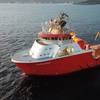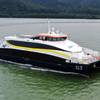A diver assigned to the Navy’s Special Clearance Team One (NSCT-1), returns to his boat for extraction during a joint training with the French Navy. The training allowed French divers to learn and observe NSCT-1 divers and the various platoons they have developed since 2002. In February, NSCT-1 members will travel to Toulon, France to switch roles and observe the French divers, mine counter measures tactics and participate in an amphibious exercise with the French Navy. U.S. Navy photo by Photographer's Mate 1st Class Alan Warner
By Photographer’s Mate 2nd Class Patricia Totemeier, Fleet Public Affairs Center Pacific
U.S. Navy Special Clearance Team (NSCT) 1 participated in a training exercise with the French navy’s mine clearance divers, Dec. 7 off the coast of Point Loma, Calif.
The training allowed the French to learn and observe NSCT 1’s very shallow water MCM (mine countermeasures) divers and their various platoons. In February, members of NSCT 1 will travel to Toulon, France, to switch roles and observe the French divers and their MCM tactics, and participate in an amphibious exercise with the French navy.
“Conducting cross-training with the French is important to the U.S. Navy,” said Lt. John M. Schiller, NSCT 1’s training officer. “If utilized as a combined task unit, we have an understanding of each other's capabilities and tactics, techniques and procedures.”
NSCT 1’s mission is to conduct low visibility underwater mine and obstacle reconnaissance and clearance operations from over the horizon to the seaward edge of the surf zone.
The French arrived Nov. 30 and stayed for 10 days. The first week was spent exercising with NSCT 1 and touring the different platoons, such as their Unmanned Underwater Vehicle, Unmanned Aerial Vehicle, and the U.S. Navy Marine Mammal platoon (NMM). NMM uses trained dolphins to detect and mark underwater mines so they later can be avoided or removed. The biological sonar of dolphins, called echolocation, makes them uniquely effective.
“We’re here to learn other techniques,” said Hugues Nagy, one of the 11 members of the French navy’s shallow water diving team. “We still have a lot to learn, but out of all the countries we’ve trained with, we have the most to learn from the United States.”
For Electronics Technician 1st Class (EOD) Brent Barto, the training exercise allowed him to show off his command’s capabilities and provide helpful information for the French.
“This exercise is a great way to help them out. Their unit is still new, and they came here to learn from the best,” said Barto. “They’re going to try our tactics and we’re going to try theirs - that’s what makes this exercise a success. They learn from us and we learn things to make us even better.”
Featured videos

Tracking Foreign Vessels Working in the U.S. Jones Act Market

Inmarsat Enhances Service to Drive Digitalization

Inside the Electrified Truckable Tug
Subscribe for
Maritime Reporter E-News
Maritime Reporter E-News is the maritime industry's largest circulation and most authoritative ENews Service, delivered to your Email five times per week









